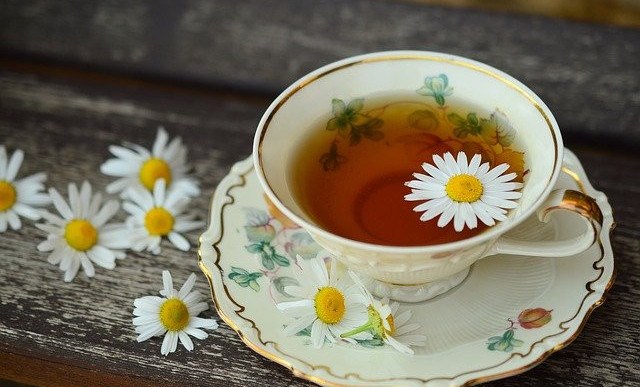At a time when it was not appropriate or polite to express strong emotions, flowers played a huge role in communication in many cultures for centuries. Flowers help to communicate emotions such as love, sympathy, appreciation, and remorse. More than just a pretty expression of emotions, flowers have been used as a source of food, drinks, and most importantly, medicine. For example, lavender flowers are used in aromatherapy for its calming properties, hops flowers are used in making sedatives, santonin flowers are used to treat worms, and chamomile flowers are not only edible, but they also have numerous medicinal uses.
In this article, we will be exploring wild chamomile flowers. Particularly we will address the question Is Wild Chamomile Flowers Good for Diabetes. And, many other potential health benefits you could expect from Wild Chamomile Flowers.
What is Wild Chamomile?
Wild chamomile, (Matricaria discoidea) commonly called pineapple weed, or disc may-weed is a cone-shaped, densely packed yellowish-green corollas annual plant native to the northeast of Asia.
The plant is also found in North America – Alaska, California, and Newfoundland, and it is naturalized in Britain. The plant grows in gardens, roadsides, and as a common herb in fields.
When crushed, pineapple weed exudes a distinct chamomile or pineapple aroma.
The disc layered flowers have been used in salads, to make herbal tea, and for various medicinal purposes such as for relieving gastrointestinal (tummy) upset, postpartum (after giving birth) anemia, fevers, and infected sores.
The flowering plant has more than 100 species, all with its distinct characteristics.
Wild Chamomile Vs Chamomile
There are different types of chamomile flowers, there are;
- Roman Chamomile,
- German Chamomile,
- Moroccan Chamomile,
- Egyptian Chamomile, and
- Wild Chamomile.
Wild chamomile or pineapple weed is a variety of the chamomile plant that has a far too sweet fragrance reminiscent of chamomile, and grows no taller than 4 inches (10.16 cm) tall. However, the two most sought after variant of the Chamomile plant is the Roman Chamomile (Anthemis nobilis), and German Chamomile (Chamomilla Recutita), for their medicinal purposes.
The Roman and German Chamomile, both contain chamazulene, which is a blue-violet aromatic compound that has been used traditionally for several purposes, including the treatment of inflammation, and for soothing skin.
The compound chamazulene is also used for protecting cells from stress caused by a byproduct of normal cellular processes (antioxidant activity).
Tip: Here are the best supplements for stress and anxiety.
Wild Chamomile Flowers Health Benefits
Chamomile plants, and its flowers are known for its beauty, fragrance, and its inclusion in the diet. However, the most important benefit of Chamomile flowers comes from its use for health purposes.
As one of the earliest garden herbs used by the Egyptians, chamomile flowers, either fresh or dried, have been used to make teas for centuries, partly due to its soothing pineapple aroma, and the numerous therapeutic properties. Some health benefits of chamomile include:
- As an Antioxidant
Loaded with antioxidants such as acetylene, and chamazulene in the terpenoids group, the chamomile flowers also contain phenolic compounds such as athletic, glucosides, quercetin, and apigenin.
With its antioxidant properties, chamomile flowers help to reduce inflammation, and even prevent cell mutation, by reducing the damage caused by free radicals. These actions against free radicals help to boost the immune system, promote healthy skin, hair, eye, teeth, nails, prevent pain, swelling and helps to lower the rate of mood disorders.
- Digestion
One of the best uses of chamomile is perhaps its use as a digestive relaxant.
Either used as an essential oil, eaten in salad, or taken as a tea, chamomile flowers help in treating gastrointestinal problems such as diarrhea, motion sickness, indigestion, anorexia, vomiting, nausea, and symptoms of acid reflux. The extract helps to shorten the course of diarrhea, thereby providing relief.
It is also used as a treatment for colic in children.
The anodyne compound in the oil produces a relaxing effect, and helps to reduce cramping, lowers constipation, and also has anti-spasmodic properties.
- Reduce Pain and Inflammation
In some cultures, Chamomile is referred to as the “Herbal Aspirin.” It is an easy remedy for the treatment of congestion, toothaches, facial swelling, skin irritations, arthritis, fever, back pain, and inflammation. Due to all its uses, It comes as no surprise that chamomile extract is added to beauty products, toothpaste, and body and face lotion.
Chamomile is also used after childbirth to lower the pain, while also soothing the mind and body.
- Relieves Congestion
The effective infection-fighting abilities of chamomile also help to lower mucus congestion. The tea, when freshly prepared, is used to treat cold sinuses, flu, infections. Inhaling the steam, or gargling the tea helps to reduce inflammation of mucous membranes of the throat, and mouth.
- For Healthy Skin
The antibacterial, and anti-inflammatory properties of chamomile, help in soothing and providing relief to irritated skin. When used as an essential oil, the flavonoid compounds penetrates deep into the skin, boosting the immune system, while also preserving the youthful appearance.
The anti-inflammatory property also helps in treating bad burns, ulcers, gout, eczema, bruises, treats dandruff, chickenpox, and even diaper rash.
- Prevents Cardiovascular Problems and Migraine Headaches
Studies have shown that the high level of flavonoid in chamomile helps to protect the cardiovascular system.
For people struggling with migraine pain, drinking chamomile tea provides relief, by reducing some of its symptoms, and it also relaxes the muscles, and therefore assure better sleep.
Some other benefits of chamomile are the treatment of cancer, reduces menstrual cramp, and treatment for allergies.
It is also used in treating various ‘chronic’ diseases such as Crohn’s disease, asthma, colitis, hemorrhoids, and even diabetes.
Tip: Remember, some essential oils can cause headaches.
Before, discussing effects of wild chamomile flowers on diabetes, let’s cover some fundamentals about diabetes.
What Is Diabetes?
Diabetes Mellitus is a chronic metabolic disease condition resulting from the increase in blood glucose level (blood sugar). This elevation of blood sugar, if uncontrolled, can lead to serious damage to vital organs such as the heart, the eyes, kidneys, blood vessels, and even nerves.
There are four types of Diabetes:
- Prediabetes
- Type 1 also called juvenile diabetes, or insulin-dependent diabetes
- Type 2 also called adult-onset diabetes or non-insulin-dependent diabetes
- Gestational diabetes
The most common type of diabetes is Type 2 diabetes, accounting for 95% of all diabetes cases presented.
Types 2 diabetes usual occurrence is in adults, thus its name as an “Adult Onset Diabetes,” and it happens as a result of the body becoming resistant to the effects of insulin, a hormone responsible for the uptake, and utilization of glucose in the blood, and by the soft tissues.
The body’s resistance to this hormone, results in elevation of blood glucose over time which needs to be properly managed, as sustained increase in blood glucose (blood sugar) level can result in permanent damage to the body, and its vital organs.
Failure to properly manage the condition, can result in the amputation of lower limbs, loss of eyesight, heart attacks, strokes, kidney failure, and even death.
Type 2 diabetes stems from lifestyle factors such as genetics, overweight, obesity, and is also prevalent in adults older than 45 years of age. The management in most cases, can be done by a change in lifestyle choices, exercises, change in diets by including more fruits, vegetables, lean proteins, and reduced carb, and sometimes medications.
Because there are no known cures for diabetes, different methods have been used in its management, including the use of chamomile flowers.
Tip: We previously covered the effects of essential oils on diabetes.
Wild Chamomile Health Benefits on Diabetes
The chamomile tea, mostly enjoyed at bedtime because of its relaxing, and sedative properties. It is not only enjoyed for its sweetness, and fruity smell, but they also have numerous health benefits that made it a popular choice in many cultures for centuries. However, one of the health benefits of the tea that is least the known is its ability to help regulate blood sugar/glucose level.
Recently, it was discovered that the pineapple scented plant help in preventing or controlling the effects of hyperglycemia associated with diabetes.
The chamomile plants contain 4 specific compounds that aid in controlling the digestion of diabetes. The 4 compounds are:
- Apigenin
- Apigenin-7-O-glucoside
The two other compounds are (Z) and (E)-2-hydroxy-4-methoxycinnamic acid glucosides.
These compounds, when acting together, help to modulate the digestion and absorption of glucose.
Several studies have shown that the effects of hyperglycemia can be reduced by the daily drinking of chamomile tea over some time. The tea also helps to suppress some enzymes linked to complications associated with diabetes, such as loss of vision, nephropathy, and neuropathy. Chamomile hot water extract has potent inhibitions to the accumulations of sorbitol in human erythrocytes, and also increase liver glycogen storage. It is also potent against aldose reductase (ALR2), and some of its components, including luteolin, quercetin, and esculetin.
Simply put, drinking a cup of chamomile or two daily with your meal along with other medications, regular exercises, and balanced diet can help regulate blood glucose level for people with diabetes, and also for people at risk of diabetes.
Tip: Make sure you avoid theses essential oils if you have diabetes.
Wild Chamomile Flowers Effect on High Blood Pressure
High blood pressure occurs when the blood is forced against the walls of the arteries of the heart resulting in a spike in systolic or diastolic pressure.
This condition is hard to detect because it hardly presents any symptoms, and can be caused by a number of conditions, including
- Diabetes
- Obesity
- Overweight
- Excessive salt in the diet, leading to fluid retention.
High blood pressure or hypertension can increase the risk of health problems, such as
- Cardiovascular disease
- Vision problem
- Fatigue, and severe headaches
- Stroke
- Kidney diseases.
Prevention and treatment of this condition may include a healthy lifestyle, regular exercise, a healthy diet, as well as drinking one or two cups of the ancient chamomile tea.
Although, chamomile is not a recommended medication for high blood pressure, the tea helps to reduce stress, ease the tension on muscles, promotes sleep, and decrease anxiety levels. It has a direct relaxing effect on the blood vessels, stimulating loss of fluid through the kidneys, in turn effectively slashing the blood pressure.
However, chamomile tea should be used cautiously in people with already low blood pressure as it can result in the risk of dizziness, weakness, injury from falls, brains, and hearts damage.
Tip: Here we discuss all about Tea and Hypertension.
What Does Research Say about Wild Chamomile Flower?
To ascertain the health benefits of the ancient plant wild chamomile that has been used for centuries in ancient Egyptian, Greek, and Roman civilization, several studies have been carried out to these effects.
Herbal medicine has been shown to have mild side effects while showing positive effects such as.
- Reducing anxiety
- Muscle relaxation, and sedative properties
- Anti-inflammatory, and antioxidant properties.
- Treatment of bacterial infections
- For menstrual cramps, and vaginitis
- Treatment of Colic in babies
- Treatment of flu, cold sore, canker sores, diarrhea, and so on.
Tip: Did you know anxiety bracelets may help some people to manage anxiety and to stay calm?
Effects of Chamomile on Complications from Chemotherapy
According to research, chamomile flowers is the single most popular herbal tea used, and contains more than 120 compounds, which include 28 terpenoids, 36 flavonoids, and other pharmacologically active ingredients.
For the management and treatment of complications associated with cancer chemotherapy such as oral mucositis, an ailment which is excruciating, and can discourage eating, and drinking in the patient, the use of chamomile extracts helps to provide relief, and is well tolerated in most patients.
Effects of Chamomile Flowers on Sleep, Anxiety, And Depression
The pathway that chamomile flowers exert its effects on sleep, anxiety, and depression is unknown. Still, it is speculated that the mechanism of action is through the neurochemical, or endocrine system.
The use of chamomile extracts in elderly patients showed an increased quality of sleep, and it also helps to reduce anxiety, and depression.
Effects of Chamomile on Migraine
The use of topical chamomile gel on patients with migraine pains decreased significantly, but should be used cautiously as it can also cause dermatitis.
Effects of Chamomile on Menstrual Cramps and Breast Pain (Mastalgia)
Most women suffer from body aches, including painful breasts during their monthly cycle that can negatively impact the quality of life. The use of chamomile extracts such as the wild chamomile flower oil, was shown to significantly reduce aches associated with menstrual cramps.
How to Use Wild Chamomile Flowers?
The very potent herb can be used in varieties of ways to access its benefits.
- Food
Chamomile flowers are edible, and can be added to salads, and can be substituted for sugary drinks as it tastes like a fruit punch.
- As Drinks
Along with other ingredients such as ginger, and lemon, chamomile can be made into ice Popsicle for throat sores.
- Bath
Chamomile flowers can be added to baths to soothe irritated skin, it can also be used as shampoos, and lotion bars.
- Salve
Chamomile is also used as a salve, to soothe eye infections, ear infections, and toothaches.
- Tea
To treat gastrointestinal disturbances such as diarrhea, colic, nausea, it can also be used to treat ulcers.
- Spray
Chamomile spray mist is used as sunburn relief.
Conclusion
Chamomile is an ancient herbal medicine that is still very popular, and used today because of its numerous bioactive phytochemicals, and its therapeutic effects.
Chamomile helps to improve health conditions such as cancer, cardiovascular problems, boosts the immune system, fight infections, acts as an antioxidant, and helps in the management of diabetes. However, the herbal extract or tea should not be taken more than twice daily to prevent adverse effects.









